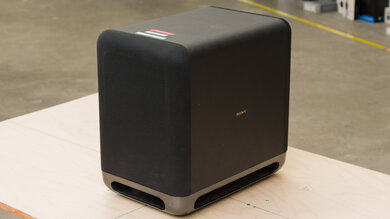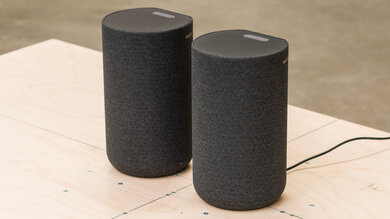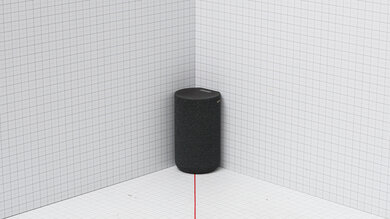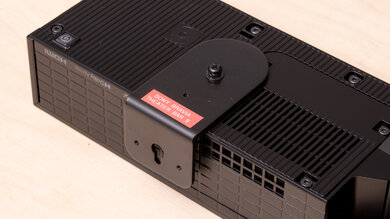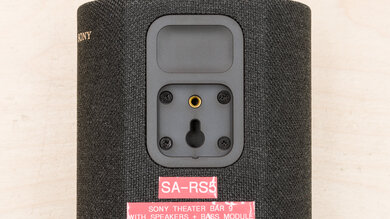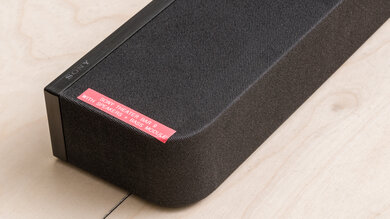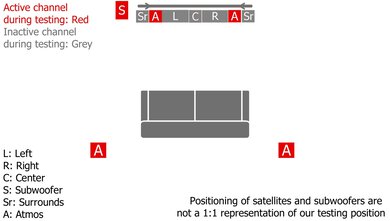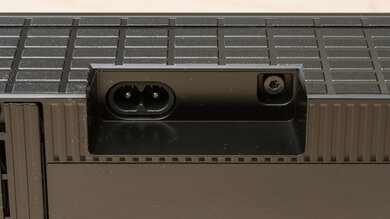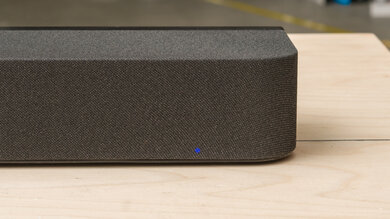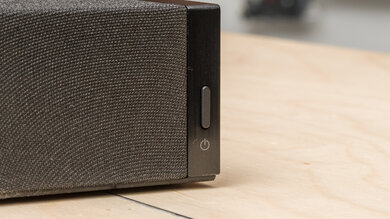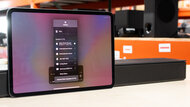The Sony BRAVIA Theater Bar 9 with Speakers + Bass Module is a 2024 model that's the expanded version of the all-in-one Sony BRAVIA Theater Bar 9. If you have room for a bar, satellites, and a subwoofer, it promises oodles of format support, including Dolby Atmos, IMAX Enhanced DTS:X, and HDMI 2.1 passthrough.
Our Verdict
The Sony BRAVIA Theater Bar 9 with speakers and bass module is very good for mixed use. Its stereo frequency response is fairly balanced with a good amount of low-end and bright treble. Its dynamics are great as well; there's not much compression, even at max volume. The soundbar supports most audio formats, so you can take advantage of object-based surround sound formats and get the most out of Blu-rays and streaming platforms, but the latency is high enough that you'll likely want to use the A/V Sync function. That said, the stereo soundstage isn't very wide, and in 5.1 surround sound, the frequency response sounds less clear, with not many sound enhancement tools available to shape it. Meanwhile, the up-firing speakers' height is okay and adjustable but not exceptionally immersive. If you're into gaming, the soundbar supports HDMI 2.1 with passthrough at 4k for a tear-free experience.
-
Support for tons of audio formats.
-
Balanced stereo frequency response.
-
Retains dynamics at high volumes well.
-
Wireless and wired connectivity for flexible use of different music platforms.
-
Audio latency is elevated.
-
Lacks manual sound enhancements like EQ.
The Sony Bar 9 with SA-SW5 + SA-RS5 is impressive for dialogue and watching TV Shows. It sounds great for stereo and center channel audio reproduction, yielding mostly balanced sound with a good amount of low-end and clear speech. The soundbar supports a myriad of different audio formats and comes with eARC and HDMI In ports for flexible connectivity. There are also 'Night' and 'Voice' modes to alter the sound for different times of the day or to emphasize speech. That said, the audio latency is on the higher end of the spectrum, so you'll likely need to adjust the A/V Sync in the app.
-
Support for tons of audio formats.
-
Balanced stereo frequency response.
-
Retains dynamics at high volumes well.
-
Audio latency is elevated.
-
Lacks manual sound enhancements like EQ.
The Sony Bar 9 with SA-SW5 + SA-RS5 is good for listening to music. Its stereo frequency response doesn't require much tweaking to get a pretty balanced sound with a good amount of low-end oomph and open-sounding vocals and cymbal hits. Its dynamics are retained well, even at high volumes, so your music doesn't get overly compressed. While it lacks a dedicated equalizer—you only get a bass adjustment—there are other sound features like room calibration and 'Sound Field Optimization', which can alter the soundstage. That said, the stereo soundstage is alright, but not especially wide and immersive. If you listen to music with different platforms, it has lots of connectivity like Bluetooth, AirPlay, and Wi-Fi, and you can use DSEE Ultimate to 'fill in' lossy audio files.
-
Balanced stereo frequency response.
-
Retains dynamics at high volumes well.
-
Wireless and wired connectivity for flexible use of different music platforms.
-
Lacks manual sound enhancements like EQ.
The Sony BRAVIA Theater Bar 9 with speakers and bass module is good for watching movies. Its stereo and center frequency responses provide ample low-end to explosions and clear dialogue. Plus, it supports virtually all of the popular audio formats, so you can listen in surround with object-based audio like Dolby Atmos with height control. That said, it's less balanced sounding in 5.1 surround, and you don't get a dedicated EQ to adjust the sound more than just the bass level. You get other features like 'Night' and 'Voice' modes, which alter the sound, though. The bar includes 'Sound Field Optimization' and room calibration, but you're still hemmed in by a lack of control over the frequency response, particularly of the satellites.
-
Support for tons of audio formats.
-
Balanced stereo frequency response.
-
Retains dynamics at high volumes well.
-
Audio latency is elevated.
-
Lacks manual sound enhancements like EQ.
- 7.8 Mixed Usage
- 8.4 Dialogue/TV Shows
- 7.7 Music
- 7.5 Movies
Changelog
-
Updated Nov 28, 2024:
We've updated the Sound Enhancement Features box to add information about the different Sound Field Settings.
- Updated Oct 18, 2024: Review published.
- Updated Oct 09, 2024: Early access published.
- Updated Sep 23, 2024: Our testers have started testing this product.
- Updated Sep 06, 2024: The product has arrived in our lab, and our testers will start evaluating it soon.
Check Price
Differences Between Sizes And Variants
You can buy the Sony Bar 9 with SA-SW5 + SA-RS5 or as a standalone, the Sony BRAVIA Theater Bar 9, which performs differently from the soundbar with the satellites and subwoofer. The soundbar kit with satellite speakers and sub only comes in one color, 'Black' (you can see the labels for the bar, one of the satellites, and the bass module). If you come across another variant of this soundbar, let us know in the comments, and we'll update our review.
Compared To Other Soundbars
The Sony BRAVIA Theater Bar 9 with speakers + bass module shares the same subwoofer as the Sony BRAVIA Theater Quad with Bass Module and Sony HT-A9 with Bass Module. Compared to those, it's a more conventional soundbar configuration with smaller satellites and a sub. Its dedicated center channel produces much clearer dialogue by comparison to both the BRAVIA Theater Quad and HT-A9 with the Bass Module, but for music, its stereo and surround soundstage isn't nearly as immersive. However, for dialogue-heavy media like reality TV and dramas, the discrete center channel on the BRAVIA Theater Bar 9 with speakers and sub produces clearer speech. Its performance and audio format support are similar to the Samsung HW-Q990D, though the Samsung has the edge with a slightly better sound when calibrated.
Check out the best soundbars, the best Dolby Atmos soundbars, and the best soundbars with subwoofers to see what fits your space best.
The Samsung HW-Q990D is better for most people than the Sony BRAVIA Theater Bar 9 with Speakers + Bass Module thanks to its bigger soundstage and more accurate frequency responses in stereo, surround, and Dolby Atmos. The Samsung offers greater connectivity and more ports, too. Still, the Sony is no slouch and offers a more excited sound by default, with support for IMAX Enhanced DTS:X, but otherwise, the Samsung is more flexible with more manual features to control the sound.
The Sony BRAVIA Theater Quad with Bass Module is a bit better than the Sony BRAVIA Theater Bar 9 with Speakers + Bass Module for most people. The dedicated four-speaker and sub bundle of the BRAVIA Theater Quad creates a more immersive surround sound experience and a bigger stereo soundstage with slightly better dynamics. On the other hand, if you watch a lot of dialogue-heavy media, the dedicated center channel of the BRAVIA Theater Bar 9 reproduces clearer speech. That said, the clarity of the BRAVIA Theater Quad's surround speakers is worth it for most people, given that neither comes with an equalizer.
Whether the LG S95TR is better for most people than the Sony BRAVIA Theater Bar 9 with Speakers + Bass Module depends on your primary usage. The LG is capable of reproducing a slightly more balanced stereo frequency response with a wider soundstage. Plus, you can EQ it and the dynamics are a bit better than the Sony's. Both soundbars support tons of audio formats, but if you're into gaming with next-gen consoles, the Sony supports HDMI 2.1 passthrough at 4k, which the LG doesn't. The Sony also has a more immersive Dolby Atmos implementation. On the other hand, the LG gives you more control over the sound, and it's capable of a bit more rumble by default.
Depending on your needs the Sony BRAVIA Theater Bar 9 with Speakers + Bass Module or Sonos Arc with Sub + One SL Speakers could be better. Sony supports a much greater selection of audio formats, as well as HDMI 2.1 passthrough, which makes it more flexible for different kinds of media and gaming. On the other hand, the Sonos has a bigger stereo soundstage and comes with Optical support for older devices. If you want to stay on top of the latest audio formats for immersive movie experiences, the Sony is better, but if you're mostly listening to stereo content or have older devices and less space to fit your setup, the Sonos might suit your needs better.
The Sony BRAVIA Theater Bar 9 with Speakers + Bass Module is a better-performing system than the Sony BRAVIA Theater Quad. That said, the Bar 9's additional bass module accounts for much of the difference. If you already have a compatible subwoofer, then you might appreciate the more immersive sound produced by the Theater Quad. But if you consume lots of dialogue-heavy content, you may appreciate the Bar 9's dedicated center channel, which keeps speech sounding clear and detailed.
Video
Test Results
The kit includes the SA-SW5 subwoofer, which is the same one as the Sony BRAVIA Theater Quad with Bass Module and Sony HT-A9 with Bass Module. Its hard plastic cabinet has an almost leathery finished texture with four rather large ports located near the bottom on each side of the sub. Inside, there’s a front-facing driver behind a nice quality fabric mesh and a down-firing driver.
The two SA-RS5 satellites are cylindrical with a flat back, which are smaller but similar in shape to the previous Sony HT-A9 with Bass Module’s included satellites. They look a bit like slightly enlarged and upscale desktop speakers that came with catalog home computers in the late 1990s. Their fabric is a different pattern from the other speakers in the kit. Each includes an up-firing driver for surround sound with height.
The soundbar is fairly wide but not very tall, so it’s unlikely to block out the bottom of your TV. Its width won’t fit between the stand of a 65-inch TV, and it’s a bit narrower than the Sony HT-A7000 with Speakers + Bass Module.
The satellites are about the height of two soda pop cans stacked on top of each other, or roughly 20% shorter than the ones included with the previous Sony HT-A9 with Bass Module. Sticking with the pop can comparison, they’re about as deep as two pop cans standing side-by-side.
You can mount the soundbar and satellites. Mounting the soundbar is straightforward, and the necessary brackets and screws to attach them to the bar are included, but you’ll need to provide your own hardware for the satellites.
The Sony BRAVIA Theater Bar 9 with Speakers and Bass Module is well-built. The bar is made of dense plastic, and a tight fabric covers most of it except towards the back. Fabric is more prone to dust collection, but it repels fingerprints at least.
The subwoofer is made of plastic with a leathery textured finish. It's rather heavy and sturdy. Its fabric grill is somewhat thin and a little loose, but it doesn't seem vulnerable to tears.
The included satellites are hefty with rubber bottoms and capped with aluminum grills on top. Their fabric grills are dense and tightly wrapped.
The Sony BRAVIA Theater Bar 9 with Speakers and Bass Module's stereo frequency response sounds great, albeit a bit excited. Its subwoofer adds ample low-bass that’s otherwise absent from the standalone Sony BRAVIA Theater Bar 9 for a lot of rumble and punch during explosions and with heavy bass like EDM music. The low-mids are pushed down in the mix somewhat, which weakens chunky rhythm guitar a bit compared to the otherwise balanced midrange, which yields clear speech and lead instruments. Trebly sounds like cymbals are rather bright and can sound shrill and piercing but very clear. Stereo content plays from the satellites as well, which creates a much wider soundstage than the Sony BRAVIA Theater Bar 9 by itself, but it tracks panning placement a bit messily as a result.
The test settings had ‘360 Spatial Sound Mapping’ and ‘Sound Field Optimization’ enabled, with the height left on default. DSEE (Sony’s digital signal processor) and Audio DRC (which stands for dynamic range compression) were disabled. The Auto Adjust Volume function was set to ‘on’ because we found the soundbar’s SPL output was considerably lower with it off.
The default test settings don't require additional tweaks to calibrate the soundbar's frequency response, which is fortunate because there's only bass adjustment available ('Min,' 'Mid,' and 'Max'). The settings used are ‘360 Spatial Sound Mapping’, ‘Sound Field Optimization’, and 'Auto Adjust Volume' enabled with the height of ‘Sound Field’ left on default. DSEE and Audio DRC are disabled.
The Sony BRAVIA Theater Bar 9 with Speakers and Bass Module's stereo soundstage is okay. It spans about as wide as the bar's width. The audio sounds somewhat unfocused, and towards the farthest edges of the soundbar, the sound is pushed towards the back of the bar. Even with stereo content, audio that's panned hard left or right will play back from both of the satellites simultaneously behind you to make the soundstage seem more immersive, though it doesn't make the soundstage seem wider.
Because the satellites are quieter than the soundbar and only reproduce audio mixed at the extremes of left and right, it's not necessarily a major distraction, but it also depends on what you're listening to. Early stereo mixes that tend to hard pan elements like percussion to one side are going to more obviously demonstrate this than most modern stereo mixes.
The Sony BRAVIA Theater Bar 9 with Speakers and Bass Module have very good stereo dynamics. There's a bit of compression in the bass at max volume, but it's not too bad, and it mainly affects boomy sound effects. The dynamic range compression 'DRC' function was disabled during testing, even though it's on 'Auto' by default when you initially hook up the soundbar.
In testing, we noticed that the max output is significantly quieter if 'Auto Adjust Volume' is disabled, so we kept it on for testing, and we expect most people will leave it on. 'Auto Adjust Volume' operates similarly to a normalized feature that tames overly loud sounds so you don't have to manually ride your volume controls. It evens out loud ads when compared to quiet sounds, like the reserved dialogue in a historical drama.
The soundbar's center channel is great. Although the soundbar has a dedicated center channel, the satellites also reproduce center channel audio. The frequency response is fairly balanced with good low-end extension, even mids, and a somewhat brighter treble for clear and articulate dialogue.
You can also connect a compatible Sony BRAVIA TV using the Acoustic Center Sync via the S-Center Out port to employ the TV's built-in speakers. However, typically, this doesn't actually improve the audio and can sometimes make it sound duller, but your results will vary depending on the TV's speakers.
The Sony BRAVIA Theater Bar 9 with Speakers and Bass Module's 5.1 surround performance is okay and is an improvement over the all-in-one Sony BRAVIA Theater Bar 9. However, the sound is much more bassy, with dull treble. Rumbles are intense, and dialogue is intelligible, but during busy action sequences, the lack of treble and strong bass emphasis can weaken speech. Unfortunately, there's no way to alter the treble's EQ.
The soundbar has two up-firing drivers, with additional ones in each satellite to add height dimension to Dolby Atmos content. The sound is warm, with punch in the bass, and a bit cluttered in the mids. Fine details in the treble range are somewhat pushed down in the mix. The impression of height is decent but lacks depth. The satellites highlight sounds coming from behind and the sides compared to the detailed and clear audio coming from the bar itself. As a result, the effect is a mixed bag depending on the content and where sounds are located in the mix, alternating from muddled tracking of moving objects to decently high and immersive sounds from behind.
The Sony BRAVIA Theater Bar 9 with Speakers and Bass Module includes limited sound customization. Most of the functions are automatic or simply on/off, such as room calibration. There's no dedicated equalizer, just three bass strengths ('Min,' 'Mid,' and 'Max'), and you can alter the height of the object-based audio. You get other features like 'Sound Field Optimization,' which optimizes the soundstage based on your room and the positioning of the speakers. You can also adjust the Sound Field settings to toggle between three settings: 360 Spatial Sound Mapping, Dolby Speaker Virtualizer, DTS Neural:X. Subjectively, we found that most content sounded best with 360 Spatial Sound Mapping, although the other modes might work better for certain content. Beyond this, there are even more modes to shape your sound, like 'Night' and 'Voice' (also known as 'Voice Zoom' with more adjustments in the app). There's also the company's digital signal processor (DSP), DSEE Ultimate, which is meant to upscale lossy audio, but it won't meaningfully improve already high-quality audio, like on Blu-rays.
There's also IMAX Enhanced DTS:X, which was added to the app after the initial release and is another object-based media format. We don't currently have a method to objectively test the performance, but subjectively, it seems to perform similarly to the soundbar's Dolby Atmos implementation, if a bit less rumbly in the bass and with more reliance on the satellites. IMAX Enhanced DTS:X currently has a narrow selection of compatible media available on services like Disney+.
The soundbar supports HDMI 2.1 with one full HDMI In and eARC port. That said, the ports are close together, so you might experience issues if your cables are especially thick when connecting them side-by-side. There's also an S-Center Out meant for hooking up a compatible Sony BRAVIA TV. The USB port on the bottom is meant for service only.
The Sony Bar 9 with SA-SW5 + SA-RS5 supports a lot of different audio formats over eARC. Common formats like Dolby Digital and DTS found on streaming services and Blu-rays are supported. In addition, object-based media formats like Dolby Atmos and IMAX Enhanced DTS:X are also supported, though the latter isn't widely adopted at the time of writing.
The audio format support via HDMI In is fantastic. Dolby Digital, DTS, as well as object-based formats like Dolby Atmos and IMAX Enhanced DTS:X are supported.
The soundbar's audio latency performance is mediocre via eARC. Latency is high enough to experience lag between your video and audio. Fortunately, the app allows you to manually adjust the A/V Sync. Some TVs also compensate for latency differently, too.
The HDMI In latency performance is sub-par on the soundbar. It's high enough that you'll mostly likely want to use the A/V Sync function in the app to manually adjust the video delay. Some TVs and apps can compensate for latency differently, though.
The soundbar supports 4k video passthrough at up to 120Hz, which is great for connecting your next-gen console. It also supports G-SYNC passthrough for tear-free gaming.
There's support for most wireless formats, like Wi-Fi and Bluetooth. Plus, you can integrate Spotify Connect and Apple AirPlay 2.
The interface is pared back with two LED indicators located on the bottom right at the front. It blinks when the volume changes. Otherwise, a white light means it's connected via eARC; green means HDMI In is selected, and blue is for Bluetooth connections. The app provides a much more complete picture of your settings.
The remote is pretty basic, but it addresses the essentials like volume, input, and different listening modes. The app offers you more control, such as adjusting the height of the up-firing drivers.



